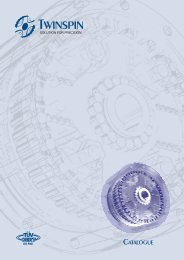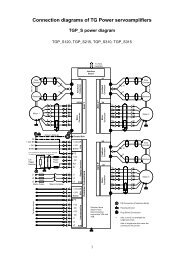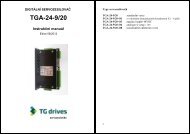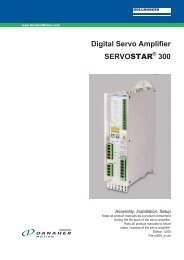Table of Contents - TG Drives
Table of Contents - TG Drives
Table of Contents - TG Drives
Create successful ePaper yourself
Turn your PDF publications into a flip-book with our unique Google optimized e-Paper software.
26<br />
Argument types<br />
executing results.<br />
The typical form for a PL program Statement is:<br />
100 Let R7 = Pg.speed / 112<br />
PL2 NATIVE POSITION LANGUAGE<br />
[Line] Mnemonic [Mnemonic Operator] [Argument] [[Operator] [Argument]]<br />
ARGUMENT TYPES<br />
SConst Short Constant, 16-bit. Can have any value between<br />
-32768 and 32767. However, not all statements use all bits.<br />
LConst Long Constant, 32-bit. Can have any value between<br />
–2147483648 and 2147483647. However, not all statements<br />
use all bits.<br />
Reg Internal 32-bit, ordinary register. Can be accessed directly as<br />
Rnnn or indirectly as R(Rnnn) (where nnn is the register<br />
number).Example:<br />
[Let] R220 = 17<br />
[Let] R(R220) = 4711 ;This will set R17 =4711<br />
XReg Designates an Extended Register. The XReg is usually an<br />
ordinary register or a system variable. Some system variables<br />
are read-only. An attempt to write to a read-only system<br />
variable has no effect.System variables are formed into groups<br />
such as,<br />
Pg<br />
Motor<br />
Pr<strong>of</strong>ile Generator<br />
The motor interface<br />
Each group has members such as:<br />
Motor.Mode<br />
Motor.Comm<br />
Motor.Poles<br />
Motor.PPR<br />
Type <strong>of</strong> motor.<br />
Commutation source.<br />
Number <strong>of</strong> motor poles.<br />
Pulses per revolution.<br />
Line Designates a line number. The range is 1 to 8191.<br />
ABBREVIATED ARGUMENT TYPES<br />
LRval Either LConst or Reg.<br />
Lval Either LConst or Xreg.<br />
RLine Either a Line or a Reg.<br />
SRval Either SConst or Reg.<br />
Sval Either SConst or Xreg.<br />
[Argument] Denotes optional argument.<br />
EXPRESSION OPERATORS<br />
The expression operator indicates the action to be performed on the two<br />
arguments.<br />
The typical form <strong>of</strong> an expression is:<br />
User's Manual 5.1 Inmotion Technologies AB<br />
Doc. No.9032 0027 01 (B), Rev. 11.07.2001

















